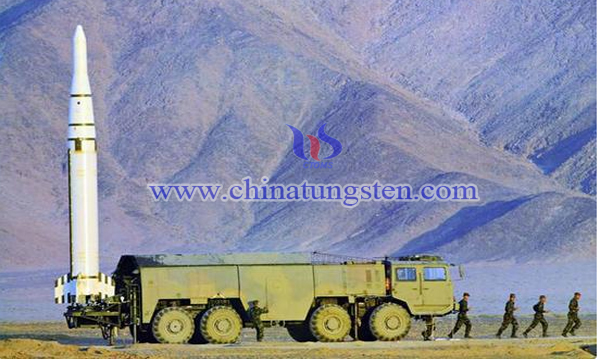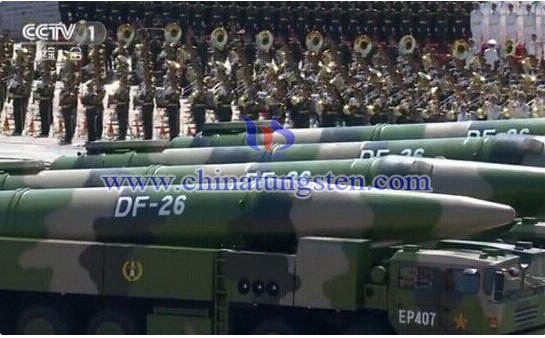How Deep can China's Tungsten Alloy Earth-Penetrating Missiles Hit?
- Details
- Category: Tungsten's News
- Published on Thursday, 07 February 2019 21:17
Ground penetrating bomb is a kind of ground attack bomb, which is composed of carrier and penetrating warhead. It carries a ground penetrating warhead (also known as penetrating warhead) and is used to attack Airport runway, ground reinforcement targets and underground facilities. On May 8, 1999, the "JDAM" bomb that destroyed the Chinese Embassy in the Federal Republic of Yugoslavia was a kind of ground penetrating bomb. It used nickel-cobalt alloy. When China saw the power of the U.S. ground penetrating bomb, it began to develop our ground penetrating bomb.

It is understood that more than 70 countries now use underground facilities for military purposes. There are more than 10,000 underground facilities in the world, of which nearly 1400 are recognized or suspected to be the locations of military strategic objectives (weapons of mass destruction, ballistic missile bases, high-level command and control centres). In addition, countries are deepening the depth and strength of the shelter. Some countries in the Middle East have built important underground facilities with a bunker depth of more than 100 meters. Therefore, without the use of nuclear weapons, how to effectively break through the bunkers deep underground has become a hot topic in the military field.
China has completely mastered all the technologies of super-high speed ground penetrating weapons around 2004. Dongfeng 15C is an improved surface-to-ground ballistic missile developed by our country after the new century. The warhead speed of the experimental study ranges from 1200 m/s to 1700 m/s. The tungsten alloy six-petal thick-walled projectile is used to design the penetration depth projectile with a diameter ratio of over 50 and a budget penetration depth of 60 m, compared with nickel-cobalt alloy, tungsten alloy has the advantage that its warhead size is smaller, but it can penetrate through thicker rock or cement, which can make up for the lack of technical experience in the design of ground penetrating projectiles in China to a certain extent.
Dongfeng 15C came into prominence in 2007 and was officially confirmed by the Western military in 2009. It is equipped with a tungsten alloy warhead with high penetration kinetic energy, with a terminal velocity of 6 Mach and a range of about 700 km, which is remarkable. The main reason for China's development of the ground-penetrating DF15 missile is that it is expected to carry out precise ground-penetrating strikes against the solid targets of the surrounding countries. Its range can cover Okinawa, Kyushu Island, northern and northwestern India, northern Vietnam and the South China Sea.
Dongfeng-15C missile is the first conventional ground penetrating ballistic missile in the world. It can give full play to the advantages of rapid response and strong penetration ability of ballistic missile in wartime, in order to accurately attack and penetrate, destroy enemy fortified aircraft fortress, permanent fortifications, underground command post and other solid targets. It can cooperate with ground-penetrating aerial guided bombs such as KAB-1500 and Tiangu 1000 equipped by the Chinese Air Force.

In recent years, in local wars, ground penetrating bombs have appeared frequently and played a great role in attacking deep-buried military targets. With the progress of drilling technology, a new generation of more powerful ground penetrating bombs are constantly emerging, and the threat to underground bunkers is growing. Experiments show that, compared with ordinary bombs with the same power, ground penetrating bombs can not only effectively destroy reinforced missile launching wells, underground command posts and other underground military targets, but also can be used to attack enemy submarines and other targets hidden in very deep ice.
At a grand military parade held in September 2016, many Chinese military observers were amazed by the weapons displayed, among which the new DF-26 medium-range ballistic missile was the most notable. According to the report, the new DF-26 medium-range ballistic missile has anti-ship capability, with a range of 3,000 to 4,000 kilometers, which is the brightest range performance besides the intercontinental ballistic missile in its nuclear arsenal. Such a range means that the DF-26 medium-range ballistic missile can also hit Guam 3,000 kilometers away from mainland China.
DF-26 medium-range ballistic missile uses two-stage solid motor. Because of the follow-up launch technology, DF-26 can maneuver in a large area on land. The satellite detects that the missile vehicle becomes more difficult, and the DF-26 has a variety of warhead delivery capabilities, large tungsten alloy ground penetrating warheads, anti-runway cluster warheads, and terminal guidance warheads capable of attacking enemy aircraft carriers can be carried. This makes the value of its conventional strikes exceptionally high, so Dongfeng 26 also has a resounding reputation as "Guam Express".
Tungsten is an important military strategic resource, which is closely related to the development of national defense industry. Therefore, in the following period of time, Xiaobian will carefully organize the knowledge of tungsten military weapons and share it with you on the website.
- Tungsten Alloy Manufacturer & Supplier, Chinatungsten Online: www.tungsten-alloy.com
- Tungsten News & Prices of China Tungsten Industry Association: www.ctia.com.cn
- Molybdenum News & Price: news.molybdenum.com.cn
- Tel.: 86 592 5129696; Fax: 86 592 5129797; Email: sales@chinatungsten.com



 sales@chinatungsten.com
sales@chinatungsten.com